Crypto Guide: Top DePIN Crypto Projects of 2024: Leading the Decentralized Infrastructure Revolution
New trends and technologies are continually reshaping the crypto landscape. The emergence of Decentralized Physical Infrastructure Networks (DePINs) stands among the most exciting prospects for 2024. From data storage and computational capability to wireless networks and geographical data, these initiatives use blockchain technology to distribute and democratize many facets of physical infrastructure. DePIN projects provide creative ideas that might completely change our interactions with and investments in the digital and physical worlds as conventional centralized systems struggle with scalability, security, and cost-efficiencies. In December 2024, the DePIN sector has a market cap of over $31 billion, as per data on CoinGecko.
We explore the top DePIN crypto projects spearheading the change toward 2024 in this article. These initiatives are worth your time regardless of your interests—investment hunting the next great opportunity or tech enthusiast curious about the direction of distributed infrastructure.
Understanding DePIN
Decentralized Physical Infrastructure Networks (DePINs) represent a pivotal shift in leveraging blockchain technology to democratize, increase efficiency, and reduce centralized control over physical systems. Large companies like Google, Amazon, and Microsoft usually oversee traditional infrastructure networks like data storage, computer power, and wireless communication, therefore generating monopolies and strong entrance barriers.
DePINs tokenize many infrastructure layers and distribute control, therefore disrupting this approach. This method improves security and openness as well as a globally dispersed, self-governing network. DePIN projects generate strong, scalable, and reasonably priced substitutes for centralized systems by motivating involvement through cryptocurrencies rewards.
The DePIN Ecosystem
The DePIN ecosystem is broadly categorized into two main types:
- Physical Resource Networks (PRNs): Among physical infrastructure including wireless communication, spatial data, transportation, and energy distribution, these networks manage and maximize For wireless networks, Helium is one example; for geospatial data, Hivemappers.
- Digital Resource Networks (DRNs): These networks provide processing power, bandwidth, and distributed storage—digital tools needed to run physical systems. Notable examples for storage are Filecoin, and for computational resources Akash Network.
This division emphasizes how flexible DePIN projects are in meeting various infrastructure requirements, which makes them essential to the developing Web3 scene.
Top DePIN Crypto Projects for 2024
1. The Graph Protocol (GRT)
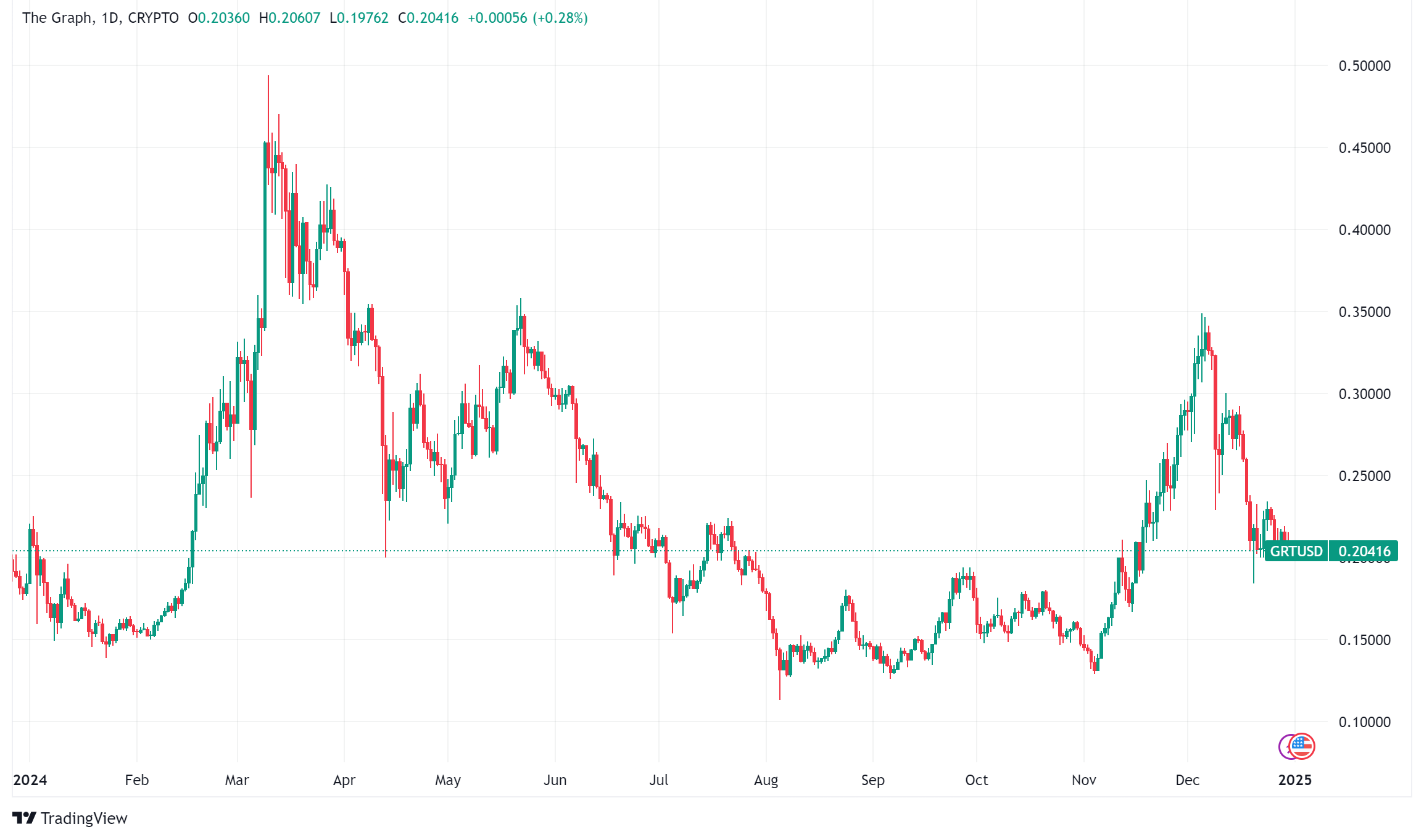
Token: GRT
Main Use Case: Decentralized data indexing and querying
The Graph Protocol is a decentralized indexing protocol that organizes online data into structured formats called Subgraphs, enabling swift retrieval by users and decentralized applications (dApps). By creating an open market for indexed blockchain data, The Graph eliminates the reliance on centralized services like AWS, positioning itself within the compute networks category of DePIN.
Key Features of The Graph Protocol
- Subgraphs: Custom indexes that enhance data querying across multiple blockchains.
- Tokenization: GRT tokens are used to pay for data queries, reward contributors, and secure the network.
- Ecosystem Integration: Widely adopted by dApps, making it a backbone for decentralized data accessibility.
Funding and Investors: The Graph has raised approximately $69.6 million from prominent investors such as FinTech Collective and Tiger Global Management, underscoring its strong foundation and growth potential.
2. Theta Network (THETA)
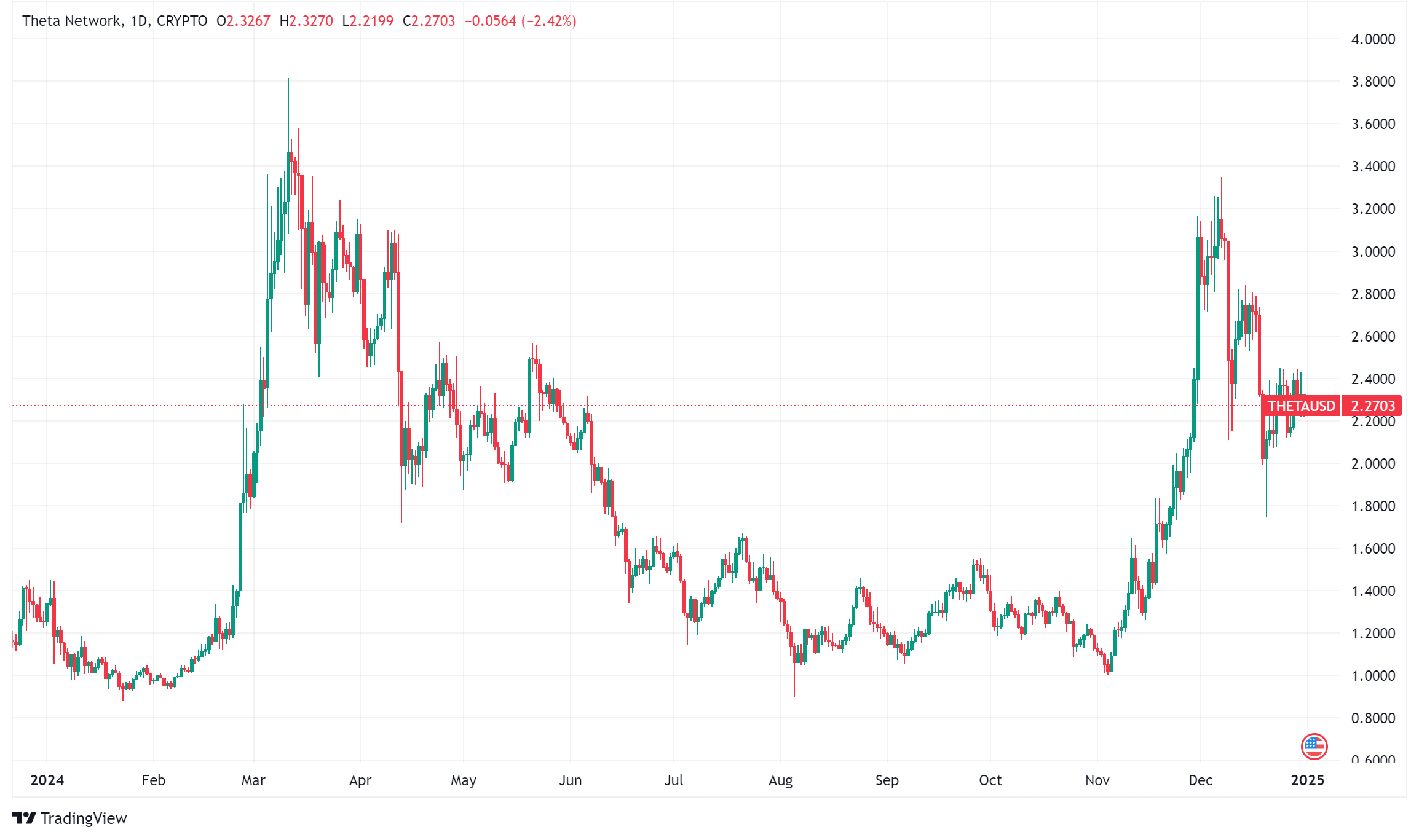
Token: THETA, TFUEL
Main Use Case: Decentralized content delivery network (CDN)
Theta Network revolutionizes the streaming industry by decentralizing video delivery and edge computing. By leveraging users’ spare bandwidth and computing resources, Theta creates a more efficient and cost-effective CDN alternative to traditional centralized services.
Key Features of Theta Network
- Proof-of-Coverage (PoC): A unique consensus algorithm that verifies network coverage and incentivizes hotspot deployment.
- Multi-Token Ecosystem: THETA for governance and staking, and TFUEL for transactions and operations.
- Theta EdgeCloud: A forthcoming decentralized cloud computing platform for AI, 3D rendering, and gaming computations.
Funding and Investors: With over $360 million raised in various funding rounds, including backing from Multicoin Capital and Andreessen Horowitz, Theta Network is well-capitalized for continued innovation and expansion.
3. Akash Network (AKT)
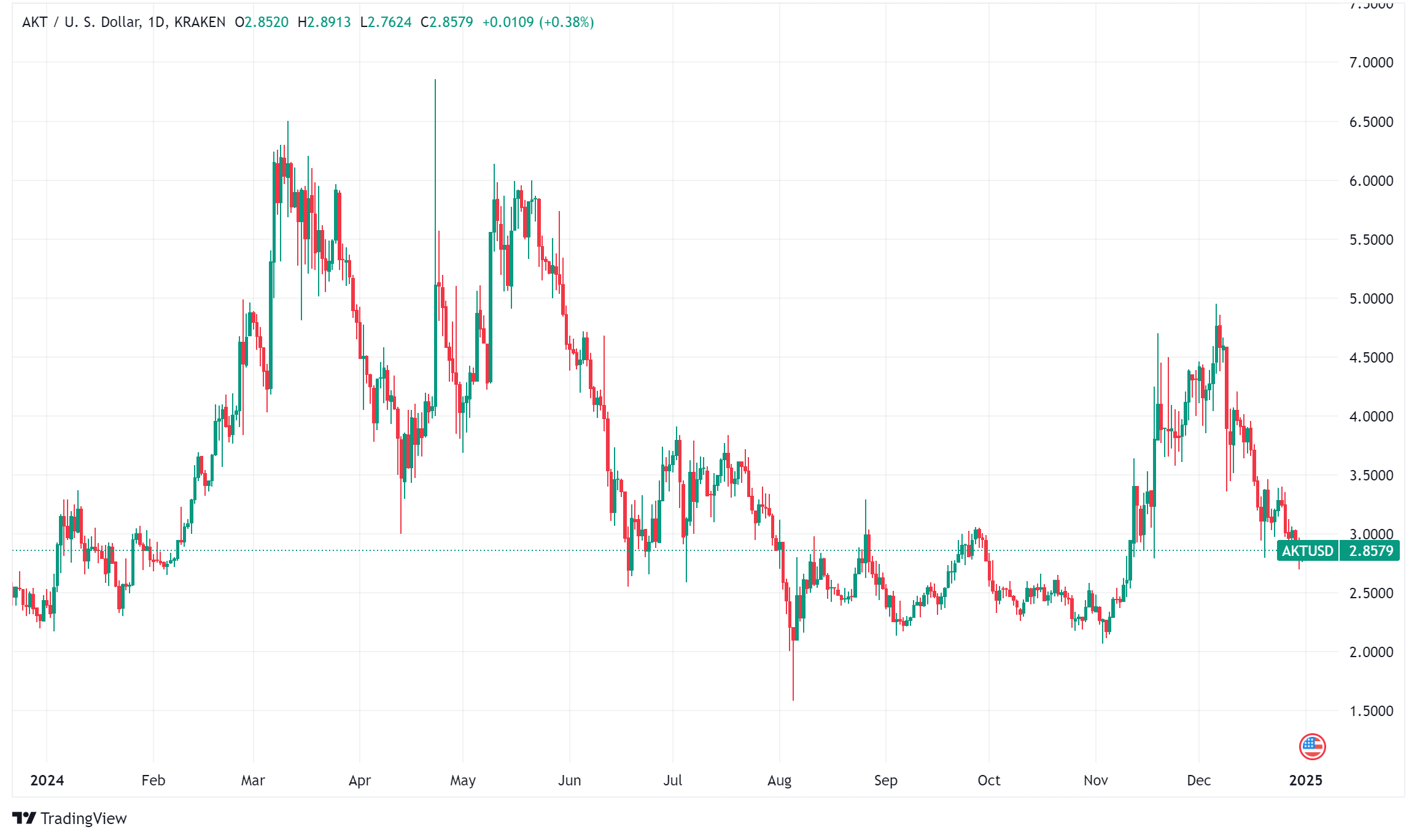
Token: AKT
Main Use Case: Decentralized cloud computing marketplace
Akash Network offers a decentralized alternative to centralized cloud services like Microsoft Azure and Google Cloud. By creating an open marketplace for compute resources, Akash enables users to rent out their spare computational power in exchange for AKT tokens.
Key Features of Akash Network
- Decentralized Marketplace: Peer-to-peer platform for buying and selling cloud computing resources.
- Cost Efficiency: Significantly cheaper than traditional cloud providers by utilizing underused resources.
- Supercloud: Enhances GPU access and provides permissionless compute resource access.
Funding and Investors: Akash has secured $2 million in seed funding, with strategic partnerships with Solana and the Cosmos Interchain Foundation enhancing its interoperability and scalability.
4. Arweave (AR)
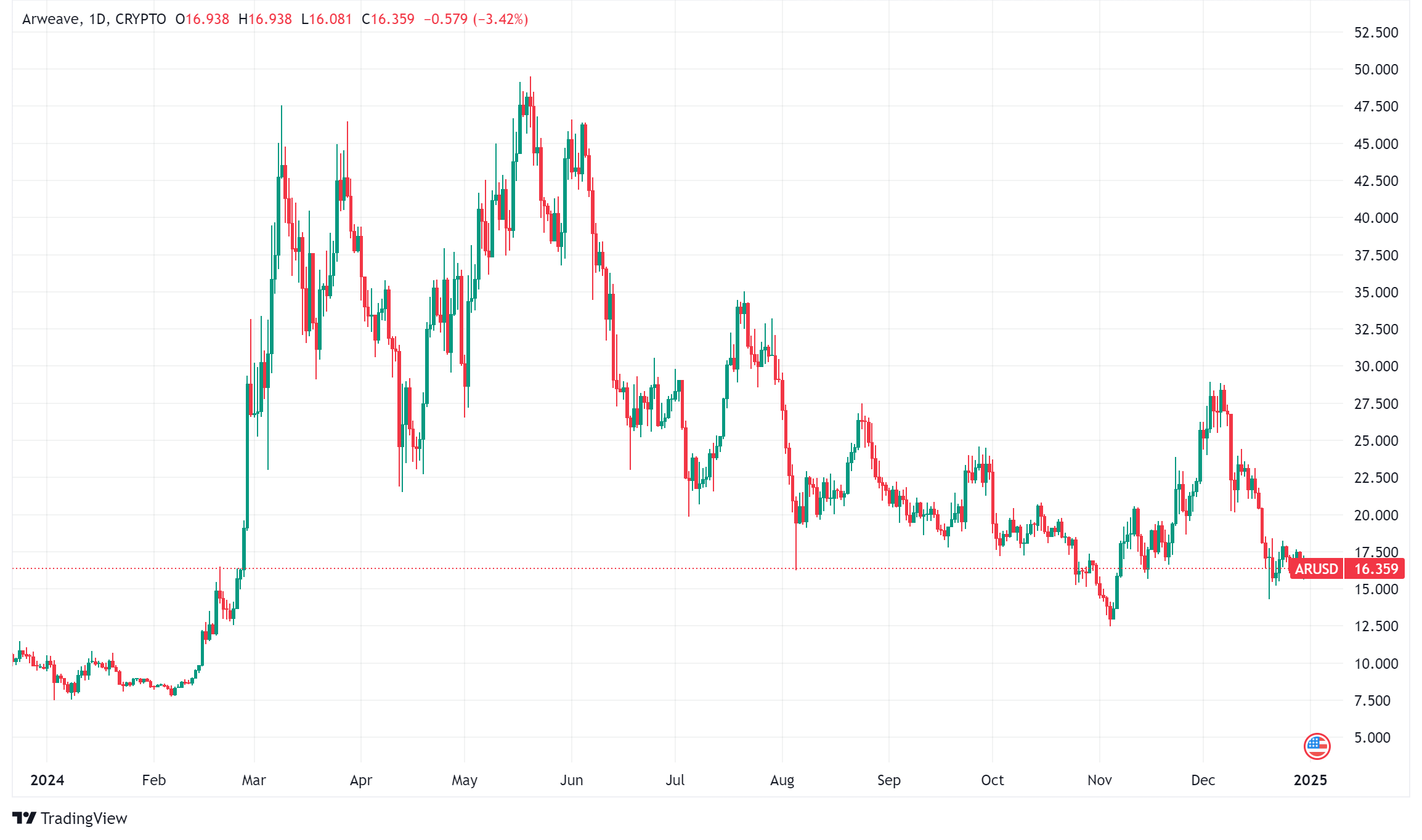
Token: AR
Main Use Case: Permanent decentralized data storage
Arweave introduces a unique “blockweave” structure that ensures permanent and immutable data storage. Users pay a one-time fee to store data indefinitely, supported by an innovative endowment model that projects storage costs over centuries.
Key Features of Arweave
- Permaweb: A decentralized web built on Arweave, hosting permanent information accessible through standard browsers.
- Succinct Proof of Random Access (SPoRA): Ensures data durability and accessibility by requiring miners to prove access to stored data.
- Endowment Framework: Sustainable model for long-term data storage costs.
Funding and Investors: Backed by Andreessen Horowitz, Union Square Ventures, and Coinbase Ventures, Arweave has a robust financial foundation to support its ambitious long-term storage goals.
5. Filecoin (FIL)
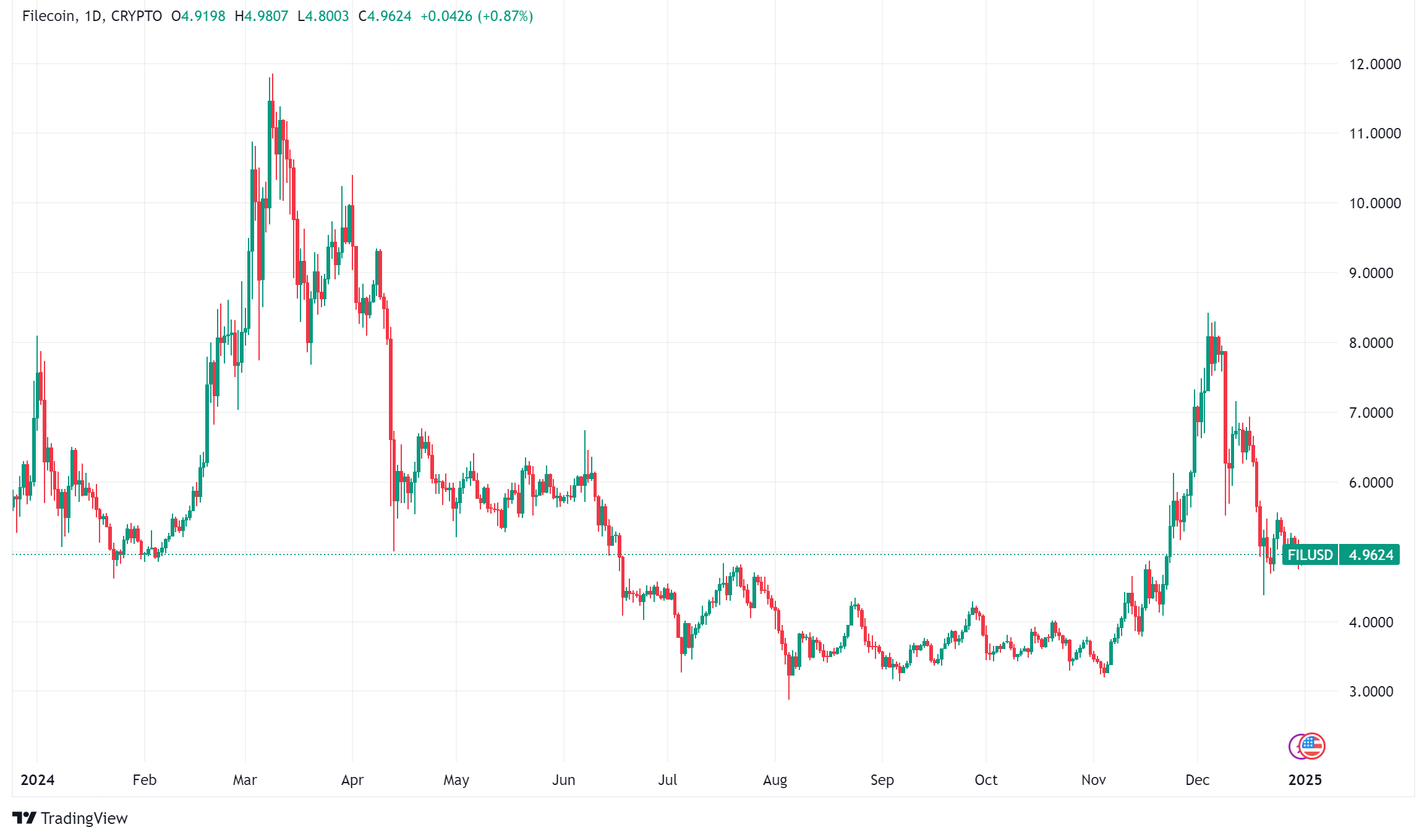
Token: FIL
Main Use Case: Decentralized data storage
Filecoin is a pioneer in decentralized storage, creating an open market where users can rent out their excess storage space. Built on the InterPlanetary File System (IPFS), Filecoin enhances data storage reliability and accessibility through its unique proof mechanisms.
Key Features of Filecoin
- Proof-of-Replication (PoRep) and Proof-of-Spacetime (PoSt): Ensure data is stored securely and reliably over time.
- Retrieval Market: Incentivizes quick data access and retrieval, fostering competition among storage providers.
- Interoperability with IPFS: Functions as a financial layer for IPFS, rewarding data persistence commitments.
Funding and Investors: Filecoin raised a groundbreaking $257 million in its initial coin offering (ICO) and continues to attract significant investments from Sequoia Capital, Andreessen Horowitz, and other leading venture firms.
6. Render Network (RNDR)
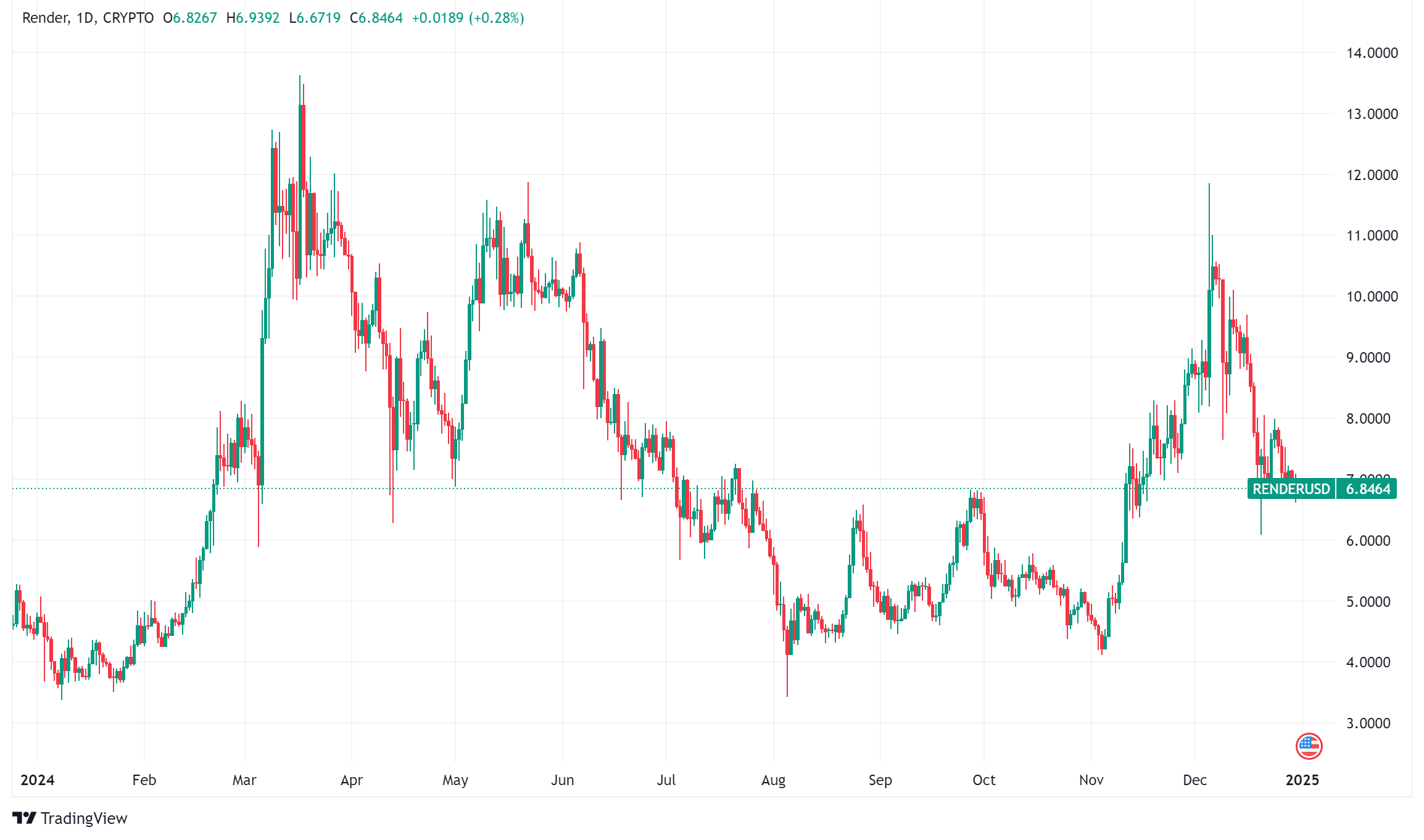
Token: RNDR
Main Use Case: Decentralized GPU rendering
Render Network connects users needing GPU rendering services with those who have spare GPU capacity, creating a decentralized marketplace for 3D rendering and AI computations. By leveraging idle GPU power, Render reduces the cost and increases the accessibility of high-performance rendering tasks.
Key Features of Render Network
- Decentralized Marketplace: Facilitates efficient allocation of GPU resources between creators and providers.
- Multi-Tier Pricing: Based on a reputation system, ensuring quality and reliability of services.
- Integration with Solana: Enhances transaction speed and scalability, making RNDR more efficient.
Funding and Investors: With a market cap of $3.2 billion and partnerships with tech giants like Apple, Render Network is a prominent player in the DePIN space, driving significant advancements in decentralized GPU rendering.
7. Helium Network (HNT)
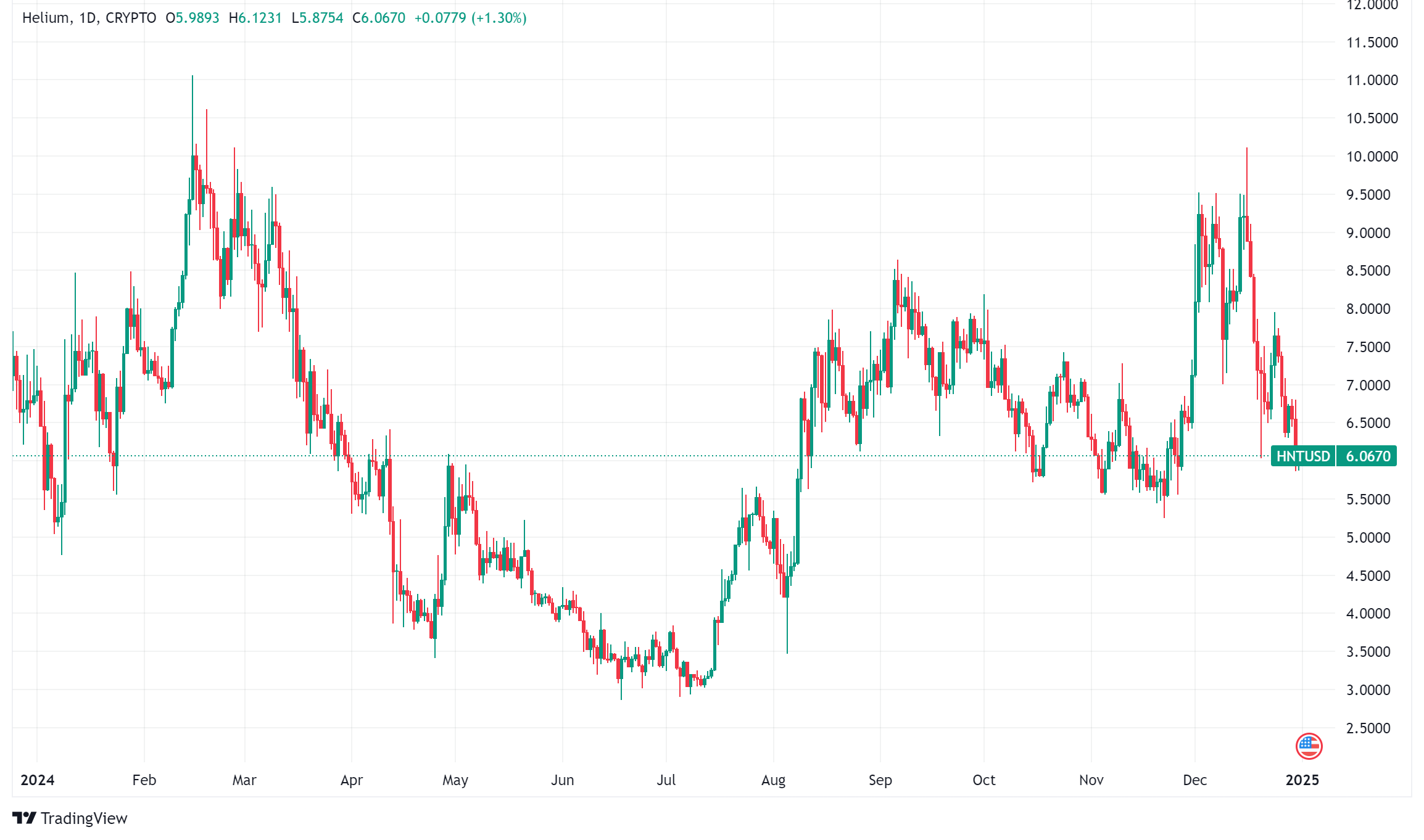
Token: HNT, IOT, MOBILE
Main Use Case: Decentralized wireless network for IoT and cellular devices
Helium builds a global decentralized wireless network using a peer-to-peer network of hotspots, providing connectivity for Internet of Things (IoT) devices and mobile applications. By incentivizing hotspot operators with HNT tokens, Helium fosters widespread network coverage and reliability.
Key Features of Helium Network
- Proof-of-Coverage (PoC): Validates the location and coverage of hotspots, ensuring network integrity.
- Multi-Token Ecosystem: HNT for rewards, IOT for IoT device connectivity, and MOBILE for cellular data services.
- Scalability: Leveraging the Solana blockchain for high transaction speeds and economic security.
Funding and Investors: Helium has raised over $360 million, with backing from Multicoin Capital, Andreessen Horowitz, and Pantera Capital, positioning it as a leading decentralized wireless network.
8. Hivemapper (HONEY)
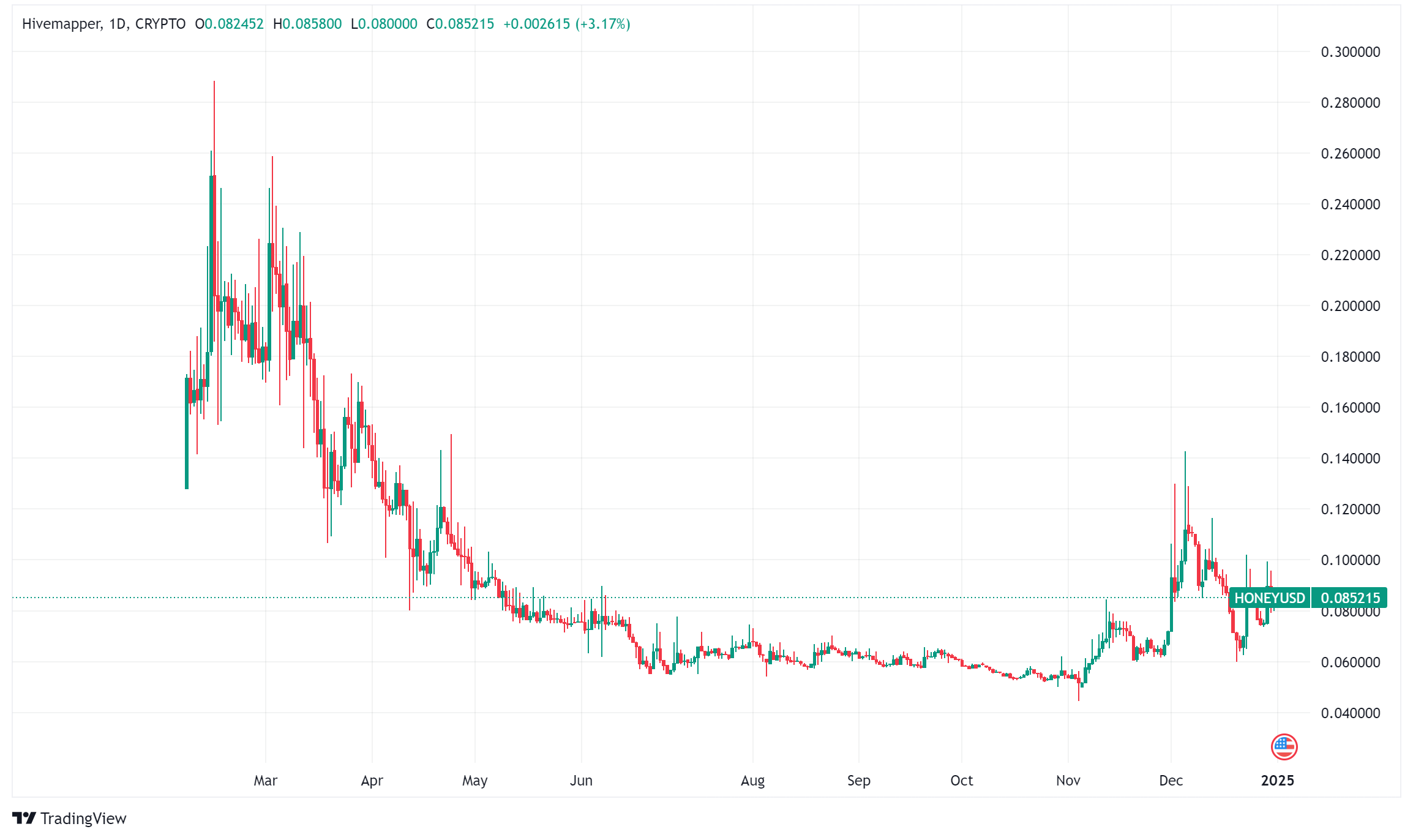
Token: HONEY
Main Use Case: Decentralized geospatial data mapping
Hivemapper creates a decentralized mapping protocol by tokenizing spatial data, enabling users to contribute street-level imagery and earn HONEY tokens. This collaborative approach to map-making enhances geospatial data accuracy and accessibility.
Key Features of Hivemapper
- Decentralization: An open market for geospatial data managed by community contributors.
- Permissionless Participation: Anyone can contribute to and access the mapping services.
- Rewards-Based Ecosystem: Users earn HONEY tokens for providing valuable geospatial data and engaging with AI trainers.
Funding and Investors: Supported by significant venture capital funding and strategic partnerships, Hivemapper is poised to redefine geospatial data collection and utilization in the Web3 era.
9. DIMO (DIMO)
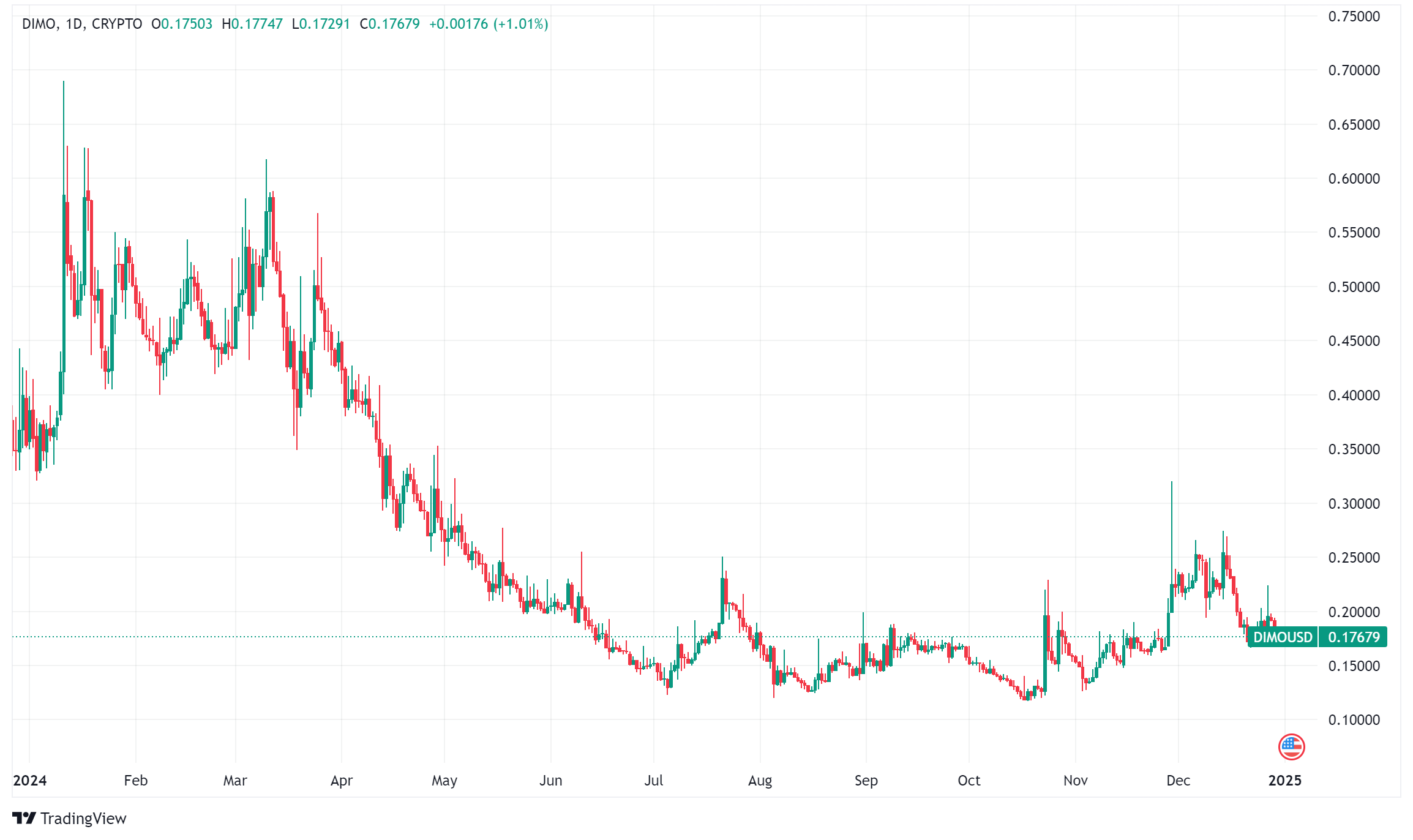
Token: DIMO
Main Use Case: Decentralized vehicle data management
DIMO transforms vehicle data management by shifting control from manufacturers to drivers. By installing DIMO hardware in their vehicles, users can securely track and monetize their vehicle’s performance and usage data through the DIMO network.
Key Features of DIMO
- User-Owned IoT Infrastructure: Drivers maintain ownership and control over their vehicle data.
- Data Monetization: Users earn DIMO tokens by selling their vehicle data, creating a new revenue stream.
- Partnerships with NATIX: Enhances data value and utility in automotive services, maintenance, and insurance sectors.
Funding and Investors: With $9 million in funding and growing interest from the automotive industry, DIMO is rapidly gaining traction as a valuable tool for drivers seeking to capitalize on their vehicle data.
10. Internet Computer (ICP)
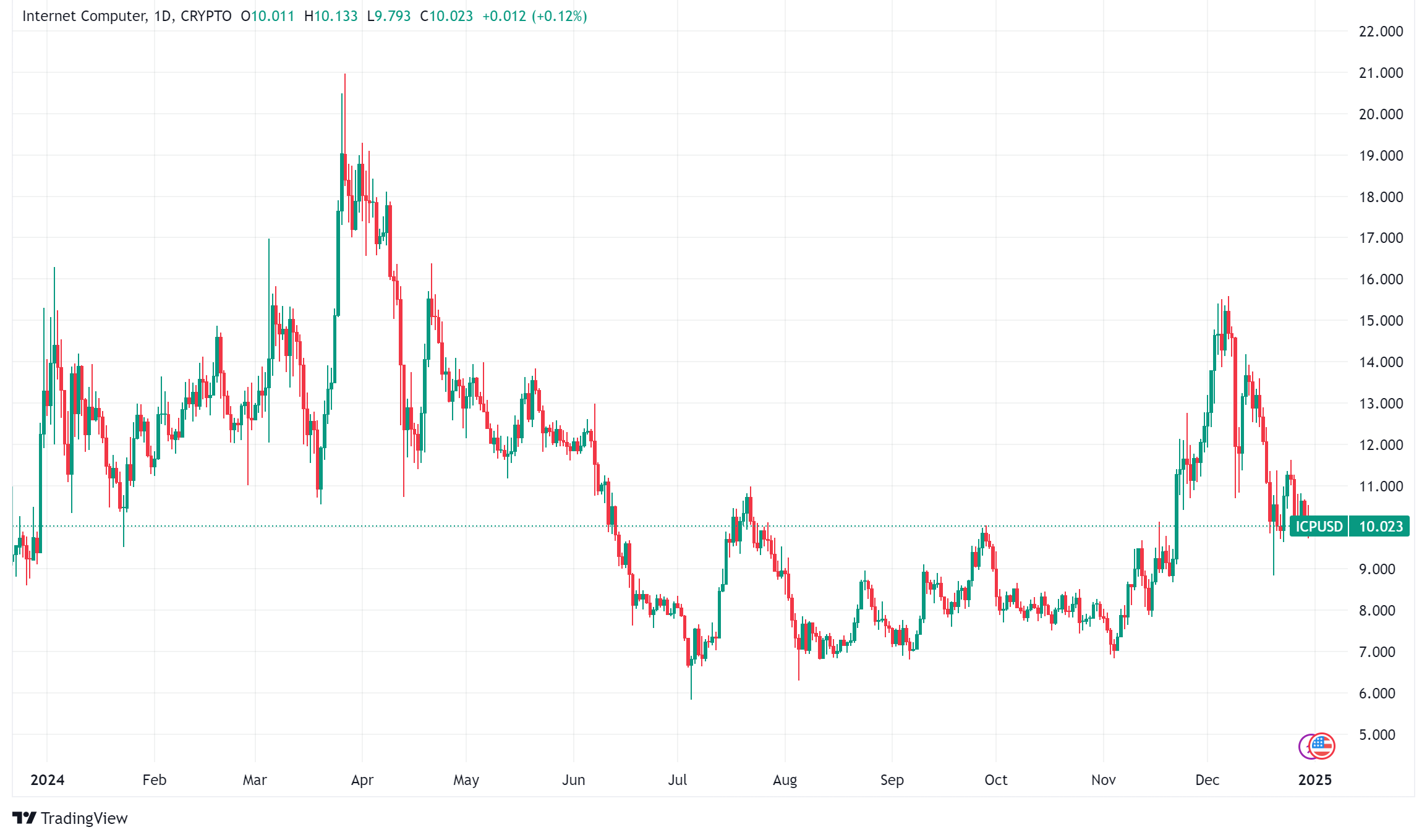
Token: ICP
Main Use Case: Fully decentralized network for hosting applications and digital assets
Internet Computer (ICP) offers a decentralized alternative to traditional IT infrastructures, enabling the hosting of applications, services, and digital assets within a secure, scalable blockchain framework. It leverages the Network Nervous System (NNS) for governance and operational management, allowing token holders to influence the platform’s development.
Key Features of Internet Computer
- Network Nervous System (NNS): Decentralized governance mechanism guiding the network’s evolution.
- Threshold Relay Consensus: Enhances scalability and security, supporting complex applications.
- Real-Time Updates: Integrates Websockets for seamless data transmission and real-time interactions.
Funding and Investors: With a market cap of $6.1 billion and continuous advancements in network capabilities, Internet Computer is a formidable force in the DePIN landscape, supported by major exchanges like Binance, Kraken, and Bybit.
Benefits and Challenges of DePIN
Benefits of DePIN Networks
- Decentralization: Reduces dependence on central authorities, enhancing transparency, security, and resilience.
- Incentivization: Token-based incentive structures encourage active participation and resource contribution.
- Permissionless Access: Democratizes participation and engagement, allowing anyone to contribute resources without geographical or institutional barriers.
- Cost Efficiency: Optimizes resource allocation, reducing operational costs compared to centralized systems.
- Scalability: Easily scales with increasing participation, ensuring robust infrastructure management.
DePIN’s Challenges
- Complexity: Integrating physical and digital infrastructure through blockchain can be technically challenging.
- Regulatory Hurdles: Navigating varying regulations across different regions can impede project deployment and growth.
- Resource Limitations: Ensuring sufficient participation and resource contribution to maintain network reliability and scalability.
- Security Risks: Protecting decentralized networks from potential cyber threats and ensuring data integrity.
- Sustainability: Long-term sustainability of tokenomics and incentive structures to support continuous network growth and participant engagement.
Future Outlook for DePIN
DePIN’s integration with developing technologies like Artificial Intelligence (AI) and the Internet of Things (IoT) will probably inspire further innovation and adoption as they continue to evolve. AI and distributed infrastructure together promises improved automation, data processing, and intelligent resource management, thereby building more flexible and adaptive systems.
Furthermore, the growing emphasis on energy efficiency and sustainability places DePIN projects in front of major actors in building more robust infrastructure systems. DePINs can help greatly to lower carbon footprints and improve energy distribution efficiency by decentralizing energy grids and supporting peer-to-peer energy trading.
For investors and tech enthusiasts alike, staying informed about the leading DePIN projects in 2024 is crucial. These projects are at the forefront of a decentralized revolution, driving innovation and offering promising avenues for growth and diversification in the ever-expanding crypto market.
FAQs on DePIN Projects
1. What is an example of DePIN?
Among DePIN initiatives are Filecoin for distributed data storage, Theta Network for distributed content delivery, and Rendering Network for distributed GPU rendering.
2. What is DePIN Solana?
Built on the Solana blockchain, DePIN projects take use of reduced transaction fees and great scalability. Among the noteworthy initiatives using Solana’s infrastructure to improve their distributed networks are Helium, Render Network, and Hivemapper.
3. Which crypto is DePIN?
Several cryptocurrencies focus on providing decentralized physical infrastructure, including Render Network (RNDR), The Graph (GRT), Helium (HNT), Theta Network (THETA), Akash Network (AKT), AIOZ Network (AIOZ), Bittensor (TAO), and DIMO (DIMO).
